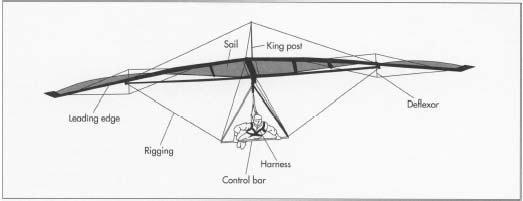Human beings have attempted to fly using devices similar to hang gliders for at least one thousand years. Oliver of Malmesbury, an English monk, is said to have leapt from a tower with wings made of cloth in the year 1020. He supposedly glided for about 600 ft (180 m) before landing and breaking both legs. Similar brief flights are said to have been made in Constantinople in the eleventh century and in Italy in 1498. The Italian artist and scientist Leonardo da Vinci made detailed sketches of various flying machines, but these devices were never built.
The most important innovation in the development of the hang glider was made by the American inventors Gertrude and Francis Rogallo. In 1948, the Rogallos applied for a patent for a flexible kite called a para-wing. Unlike other kites, the Rogallo design had no rigid supports. Instead, it remained limp until it was given firm but temporary shape by the wind in flight. The development of Mylar, an extremely light, strong plastic, improved the performance of the Rogallo kite.
http://open-site.org/Recreation/Aviation/Aircraft/Flex_Wing/Hang_Glider/History/Images
http://www.independent.co.uk/news/obituaries/francis-rogallo-engineer-whose-work-paved-the-way-for-hanggliders-1783822.html
In the late 1950s, the United States government took an interest in the Rogallo design for use in parachutes designed to return spacecraft to Earth. Experiments were also made in building large powered Rogallo kites for military transportation. Inspired by reports of these experiments, the American engineer Thomas Purcell build a 16 ft (4.9 m) wide Rogallo glider with an aluminum frame, wheels, a seat to hold a passenger, and basic control rods in 1961. This was the first true hang glider. Early hang gliders were also built in the United States from bamboo by Barry Hill Palmer in 1961 and in Australia from aluminum by John Dickenson in 1963.

A hang glider consists of a wing, a frame, cables, and items to hold these parts in place. The wing, also known as the sail, is made from a strong, light plastic. The frame of a hang glider, also known as the airframe, is made from an alloy of aluminum and other metals, such as magnesium, zinc, and copper.
http://www.madehow.com/Volume-5/Hang-Glider.html











 ^After the delicious lunch, we went back to the activity room and start our work quickly. Fayuan and me were given the work to make the glider's tale wing, while Xiuqing and Azrul were making the main wing of the glider
^After the delicious lunch, we went back to the activity room and start our work quickly. Fayuan and me were given the work to make the glider's tale wing, while Xiuqing and Azrul were making the main wing of the glider



























